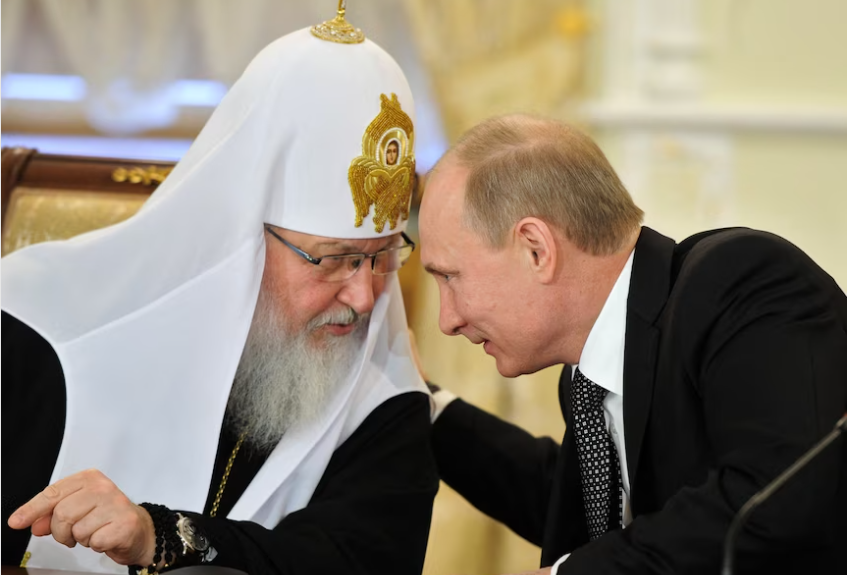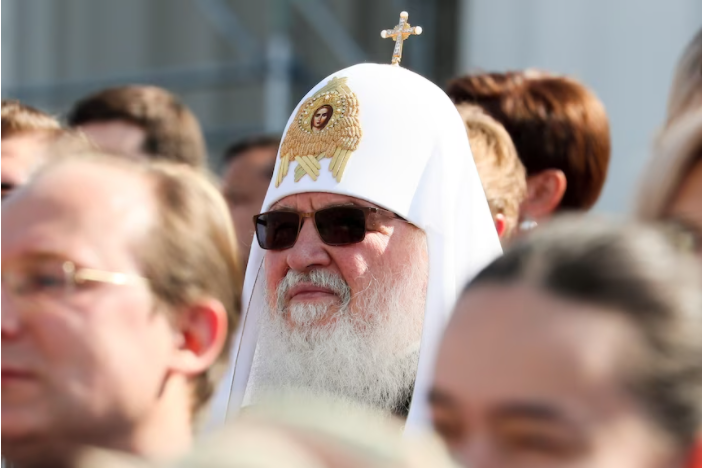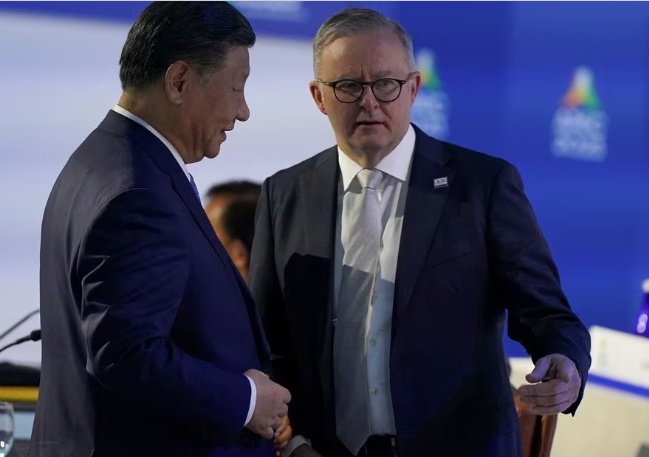
When Patriarch Kirill sat down with Russian Justice Minister Alexander Konovalov he might not have realised the meeting would embroil him in controversy.
His attire was typical of a man of the cloth. His white headscarf was embossed with religious symbols and a gold cross signified his senior status within the church.
But an object adorning his left wrist would later come back to haunt him: a designer watch.
For years, rumours swirled around this flashy piece of jewellery after it was first spotted on the patriarch during a tour of Ukraine in 2009.
With the esteemed religious figure’s designer collection an object of fascination online, a doctored image of the meeting appeared on the church’s official website in April 2012.
In the photo, the $US30,000 ($43,375) Réveil du Tsar model watch disappeared under an extended black sleeve.
No-one would have been the wiser if it wasn’t for a tiny, telling detail, which gave the lie away.
Eagle-eyed bloggers were quick to pick up on a blurry reflection of the timepiece lurking just below the patriarch’s hands on the highly glossed table.
The terrible airbrushing was mocked online, calling the moral authority of the church into question and embarrassing senior figures.
An overeager staff member was blamed for the incident, and the church promised the manipulation would be investigated and “the guilty ones punished severely”.
But Patriarch Kirill was unfazed, admitting he owned the Breguet timepiece, but kept it in its box.
Expensive watches, he said, were not part of his official attire.
The mysterious leader wields enormous influence as the head of the Russian Orthodox Church, bestowing guidance to more than 100 million believers — about 70 per cent of the country’s population.

It also makes him a useful ally to Russian President Vladimir Putin.
The pair appear to have struck a mutually beneficial alliance that offers Russia’s leader spiritual cover in exchange for the Kremlin’s influence.
The young priest who became disillusioned with the West
Born Vladimir Mikhailovich Gundyayev, Russia’s future patriarch grew up in a compact apartment in Leningrad during the Soviet empire
From an early age, his path led him to the religion of his father and grandfather.
His family suffered for their faith under the repressive Communist regime, spending years inside gulags on trumped-up charges.
Gundyayev heard these accounts and watched as authorities systematically shut down churches, but remained committed to the church, entering the Leningrad Seminary after high school and rounding off his studies at the Leningrad Theological Academy.
By 1970 he had abandoned his childhood name and was rechristened Father Kirill after the saint, Cyril the Philosopher, a theological scholar who championed the Orthodox Church above all others.
He traded a formal education in Oxford for a real-life one in Geneva, spending the decade travelling abroad and serving as the Moscow Patriarchate representative at the World Council of Churches in Geneva.
“My work at international organisations was worth another university course and … would help me a great deal in the future,” he told TASS.
The KGB spy and the misfit
The young priest also became disillusioned with the West, claiming he saw the beginning of its moral degradation first hand.
When a group of Protestants put forward the possibility of admitting women into priesthood during an All-Christian congress in 1974, Father Kirill applied all his energies to preventing it.
“I witnessed a deepening crisis,” he said in a documentary devoted to his 70th birthday, which aired on Russian state television in November 2016.
Within Russia he had earned a reputation as a “zapadnik” — a pro-Westerner — but likely maintained deep links to Russia’s state apparatus, principally the KGB.
Membership of the Soviet spy agency was a requirement for any religious figure who travelled abroad, according to a paper called The Mikhailov Files: Patriarch Kirill and the KGB, by historian and human rights activist Felix Corley.
Kirill’s predecessor, Patriarch Alexy II, was outed as a fully fledged KGB agent in secret documents uncovered in Estonia in 1999.
After ascending to the rank of archbishop in 1976, Kirill spent the next 20 years developing a uniquely modern, but deeply conservative style of worship.
With a fondness for stocks, car racing, downhill skiing, and breeding exclusive kinds of dogs, he did not fall into the typical depictions of a man of faith.
But that didn’t matter to Vladimir Putin.
How Putin helped shore up Kirill’s power and wealth
Mystery surrounds the first meeting between patriarch and president, but both men ascended to the height of their powers shortly after the fall of the Soviet Union.
The Russian Orthodox Church emerged from the Soviet era with a mission to regain its status as Russia’s most powerful ideological institution and ultimate moral authority.
Those at the top set about rebuilding the congregation and their places of worship, after decades of persecution and the destruction of thousands of churches.
But some of the ways they used their new-found privileges stoked controversy.
When church departments, including Kirill’s, were accused of profiteering in the import of millions of dollars’ worth of duty-free tobacco and alcohol in the mid-1990s, critics pushed for more transparency about the institution’s shadowy finances.
More than two decades later, the situation remains cloudy.
In 2020, former in-house journalist Sergei Chapnin wrote that “Orthodox congregations in Russia have developed a completely incomprehensible accounting system”, necessitated by a “profoundly corrupt” administrative structure.
Through the early 2000s, Kirill maintained the church was “completely separate from the state apparatus”, once declaring that clerics would never involve themselves in politics.
But by the time he was enthroned as the church’s new leader in 2009, who should appear at the side of the altar but then-prime minister Vladimir Putin and his seat-warmer, Dmitry Medvedev.
The president and the patriarch have maintained a close relationship, with Kirill once describing Putin’s ascension to power as “a miracle of God”.
Putin has also leaned on Christian symbolism and ideology to cement his popularity with the Russian public, and once suggested it was Kirill’s own father who secretly baptised him in 1952.
“[Putin] really depends on the church for his legitimacy,” says Chrissy Stroop, senior correspondent for Religion Dispatches and a scholar in modern Russian history.
“He cannot entirely alienate the church because he has embraced … essentially a kind of Christian nationalist ideology as something to unify the Russian state. Just like in the Russian Empire, before Soviet times.”
After Patriarch Kirill endorsed Vladimir Putin’s return to the presidency in 2012, the Russian Orthodox Church continued to steadily increase its wealth.
Is Putin secretly the world’s richest man?
Aside from parishioners’ donations and income from its in-house TV channel and “Sofrino” factory, which produces everything from priests’ robes to church pews to candlesticks, the church relies heavily on the Kremlin.
It has reaped tens of millions of dollars in state funding for religious schools and grants to reconstruct old churches that were destroyed during the Soviet era.
According to a 2016 investigation by RBC, the church and its affiliates received 14 billion rubles ($290 million) from the government between 2012 and 2015.
The man who commands this institution has also amassed a significant fortune since his rise to the top — but estimates of his wealth are virtually impossible to verify.
The church has done its utmost to downplay the leader’s image as a member of the Russian elite.
It has gone to great lengths to explain the patriarch’s use of luxury yachts, private jets, exclusive mansions and other gifts donated by various Russian benefactors — including the infamous gold watch.
The patriarch is also understood to oversee a sprawling private property portfolio of his own, including three apartments under his name in Moscow and St Petersburg.
Meanwhile, the Kremlin has reportedly spent millions on remodelling part of the 2.5-hectare St Petersburg property that once housed Russia’s imperial family, and was designated as church property in 1994.
In 2018, the presidential property office awarded a $43.4-million contract for renovations to allow Patriarch Kirill to work and reside on the palatial grounds.
And yet, Patriarch Kirill frequently preaches the dangers of accumulating extravagant wealth, warning Russians who indulge without sharing their spoils with those in need are “on a path to hell”.
But it’s his sermons on the virtue of war in Ukraine that have demonstrated the close ties between the patriarch and Putin.
Kirill’s enduring support for the man inside the Kremlin
Over the years Patriarch Kirill has frequently come to the defence of Vladimir Putin.
When feminist punk band Pussy Riot staged an unsanctioned musical protest in the Cathedral of Christ the Saviour in 2012, asking for the Virgin Mary to “chase Putin out”, Kirill dismissed calls for leniency and backed jail time.
The church has also been supportive of Russia’s military efforts overseas, in some cases working as a key communication tool for the Kremlin.
When Russian forces entered Syria in 2015 to fight off Islamic State terrorists, Patriarch Kirill described their cause as “surprisingly noble and honest”, and driven not by political strategy but “in defence of our Christian Orthodox brethren”.
Just as Putin’s proxies establish his power across Africa, the Russian Orthodox Church is vying for influence across the continent, establishing dioceses in Cairo and Johannesburg in 2021.
The church is also in step with the Kremlin in Europe, undermining NATO and EU aspirations in Moldova and Montenegro, and in Iran, where it hosts an Islam-Orthodoxy dialogue every few years.
Most recently, Patriarch Kirill has been a vocal supporter of the war in Ukraine, blessing troops in his weekly sermons and espousing the familiar nationalistic narrative that paints eastern Ukraine as rightfully Russian.
In his first sermon after Putin sent his troops across the border, Patriarch Kirill blamed “Western values” for the unfolding violence, describing a struggle of “metaphysical significance”.
“Someone must pray for our united people. Someone must defend God’s truth that we are really one people,” he told his followers a few weeks later.
His endorsement for the Russian campaign prompted swift backlash, including financial sanctions from the UK and a warning from Catholic Pope Francis, against becoming an “altar boy” for Vladimir Putin.
But the patriarch has not backed down from his support.
After Putin’s military mobilisation drafted in thousands of young Russians to replace his dwindling forces in September, the patriarch told his followers their sacrifice on the battlefield would “wash away all your sins”.
Putin’s only friend worries Ukraine
Earlier this month, he called for a temporary ceasefire to allow Ukrainians and Russians alike to observe Orthodox Christmas, which Putin announced his troops would comply with across the front line.
No such reprieve came. Ukraine, which had immediately rejected the idea as a hypocritical ploy to halt their advances in Donbas, reported Russian forces continued firing in several areas.
“In a way, the aim of the ceasefire proposal was to force the Ukrainian army and politicians to reject it in view of the Ukrainian public,” wrote Alexander Baunov, a senior fellow at the Carnegie Endowment for International Peace.
“In this context, the proposal fits into the Kremlin’s version of the situation, in which there are some good, potentially pro-Russian Ukrainians on one hand, and an occupying army of Ukrainian nationalists on the other.”
Now pilloried as a puppet of Putin’s regime, Kirill has become isolated, even within his own church.
The new schism and Kirill’s precarious position
The Eastern Orthodox Church comprises 17 self-governing churches that recognise each others’ autonomy in various parts of the world.
While patriarchs are ultimately responsible for affairs within their own domains, the Ecumenical Patriarch of Constantinople (Istanbul) is seen by many as the spiritual centre.
But for decades, Kirill has made clear his intention for Russia — which accounts for about half of the world’s Orthodox population — to be regarded as the highest authority.
“The Russian Orthodox Church holds de facto first place among all of the other Orthodox churches … we are rightful heirs of Byzantium,” he declared as Metropolitan of Smolensk in 2005.
The Moscow and Constantinople patriarchates have been jockeying for power for centuries, but recent tensions came to a head in 2019 when Patriarch Bartholemew allowed the Ukrainian Orthodox Church to break away from Russia and establish its own self-governing body.
Patriarch Kirill refused to recognise the decision and severed ties with Constantinople completely, setting in motion one of the greatest schisms in the church’s modern history.
Stroop says the kind of soft power Patriarch Kirill appears to be chasing has always been central to the Russian Orthodox Church mission, and neatly aligned with the Russian state.
“[From Putin’s point of view], this whole split is also about who has the right to expect compliance or deference of other Orthodox Christians in the world,” she said.
“That’s kind of a radical view, but it’s a very pro-Russian nationalism, which is very consistent indeed with Kirill’s career.”
Since ramping up his anti-Ukrainian rhetoric during Putin’s war, the rift has deepened even further, with believers across Europe and the United States switching their allegiances.
Where Ukraine fits into Vladimir Putin’s ‘culture war’
More than 272 clerics from around the world signed an online letter, calling for an immediate end of the invasion.
“It is damaging to the prestige of the whole of Orthodoxy because Orthodoxy doesn’t support war, violence, terrorism,” Patriarch Bartholomew told the New York Times last year.
But there may be other political calculations at play.
For people like Kirill, who worked their way up the clerical ranks during the tumultuous Soviet period, the memory of state crackdowns is very much alive.
As Stroop explains, they were only able to regain their positions of influence by cooperating with the state, so it is in their self-interest to continue operating this way.
“People of a certain age, like Patriarch Kirill, they were part of the structure, and in a sense, they’ve returned to it except with a state ideology that is much more congenial to them,” Stroop said.
“He doesn’t know how to do anything else. If he were to go against the church, it wouldn’t go well for him.”


